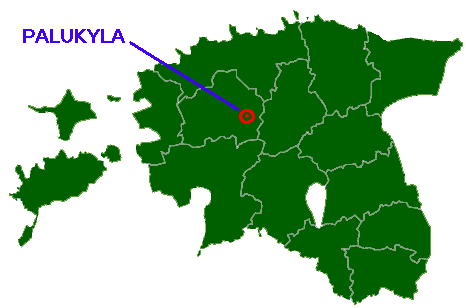Description of Sacred Hill of Palukyla 
The Sacred Hill of Palukyla (Palukyla Hiiemägi) is situated in Rapla parish, in modern Rapla county and in Kehtna municipality. There are more written texts about the sacred site of Palukyla Hiiemägi than about most other natural sacred sites. According to tradition, there should be honourable attitude towards the sacred site, nature and ancestors on the hill. These customs are common to all other natural sacred sites in our country.
Palukyla Hiiemägi is the highest hill in historic Harjumaa county. Still it is no more than 25 meters high from the foot. Stories from the previous independence period (1920’s-30’s) tell that first part of the crop yield, killed animal, beer or other was given as a gift to the hill. Holidays of the folk calendar, such as Midsummer Day or Shrove Tuesday have also been celebrated on the hill. Wrong actions brought its consequences: after many alder-trees were cut on the hill, many heads of cattle died in the village. Many people still feel great honour for the sacred hill. Meetings of the people following old native traditions and celebrating holidays of folk calendar take place. Besides, many people come alone or with small company to enjoy nature, one hillside is well-known place for going down on a sledge or skis.
The area of the Palukyla Hiiemägi is approximately 35 hectares, the height from foot is about 25 meters. The hill has preserved its natural relief and is under nature protection, laying on the landscape conservation area and simultaneously on Natura 2000 Special Area of Conservation and Special Protection Area for birds.
The majority of the hill is covered with forest. On the southern side of the hill is a Natura 2000 habitat of Community interest belonging to the type “6210 - semi-natural dry grasslands and scrubland facies on calcareous substrates (
Festuco-Brometalia) (*important orchid sites)”. The forest looks natural on Palukyla hill, it inhabits a protected species - red wood ants.
About the sport centre planned on the hill and its neighbourhood
The board of Kehtna municipality has planned to establish a ski resort and sport centre on the hill and in the vicinity of the hill. Among the rest, ski lifters and pipes with machines to make artificial snow on the hill have been projected. These attributes would demand excavating operations on the hill. There are other plans to widen ski tracks on the hill and to illuminate them. Rather big service building (450 m2) is planned to be built beside the hill. The board and officials of municipality have claimed that, in their opinion, only one top of the hill should be considered as a sacred site and that would not be directly touched by the development plans. Such approach is however in disagreement with knowledge of local people and standpoints of folklorists and historians. However, in the present (beginning of 2011) only fraction of the hill is under preservation as a cultural heritage – the part of the Palukyla Hiiemägi, where the altitude is the highest (106 meters above sea).Plans to alter the hill have found resistance both among local people and those living in other regions. For protection of the hill more than 1800 people signed a letter. See the call for protecting hill: http://www.maavald.ee/en/religion-and-culture/369-help-save-the-sacred-hill. Nevertheless, the plan was accepted by municipality council in September and December 2004. This decision was sued, because it was found that activity that damages natural values is not proper for natural sacred site and would make it impossible to follow the traditions in the way of the ancestors. Three national court levels made different decisions, but the final, State Court, did not find development plans to be against the law.
The officials who should have stood for the protection of natural values and historical heritage fully supported the development plans of the resort and even promoted the plans of municipality board in court. The chief of Environmental board of Rapla county arbitrarily and erroneously invalidated the presence of Natura 2000 habitat on Palukyla Hiiemägi. The official responsible for protection of cultural heritage also supported establishment of the resort, claiming that it would not damage the natural sacred site, and, on contrary, would be beneficial.
During the last hundred years, many activities have already damaged the sacred hill. About four decades ago, motorcyclists rode over the hill during competitions. Besides, some gravel was excavated for building a pig farm of kolkhoz in Lelle. However, both excavating and cycling were ceased to conserve hill’s naturalness. In last decades, the municipality has arranged forest cuttings on the hill, which have repeatedly over limited allowed quantities. The planned attractions of ski resort would change the landscape and character of the place even stronger than previous thoughtless actions.
The plans of creating a big ski resort have still not been realized. There are no ski-lifts nor water-pipes that demand excavating operations. Ski tracks on the Palukyla hill are also not illuminated. At present (beginning of 2011), Kehtna municipality is applying for about 1,9 million euro to establish a great ski resort and sport centre asking money for that purpose from the structural funds of European Union via Enterprise Estonia (http://www.eas.ee/index.php?setlang=en-GB). The Union for Protecting Palukyla Sacred Hill and the organization of native Estonians, Maavalla Koda, have expressed an opinion that the planned resort and sport centre would be in conflict with ancient traditions, would damage the natural sacred site of Palukyla Hiiemägi and related to that, eliminate opportunities to follow ancestors’ accustoms.
People who respect natural and cultural heritage find that plans should be looked over. A well-placed house oriented to nature education and helping visitors would be proper instead of a big sport and resort centre.
Photos about Paluküla Hiiemägi: http://palukyla.maavald.ee/pildid


